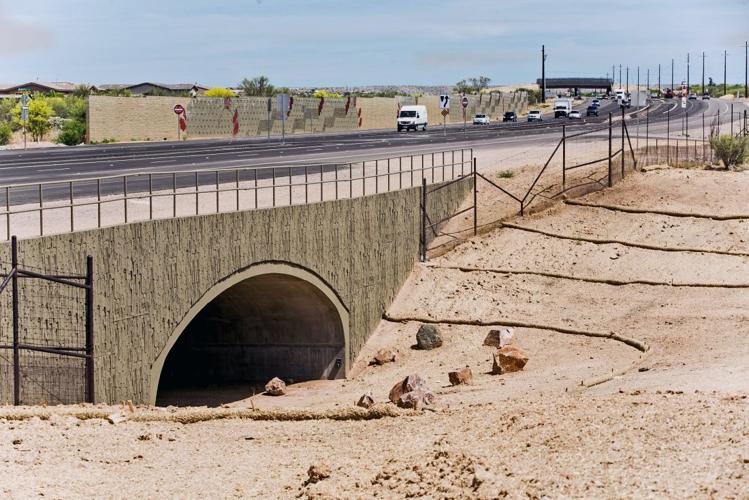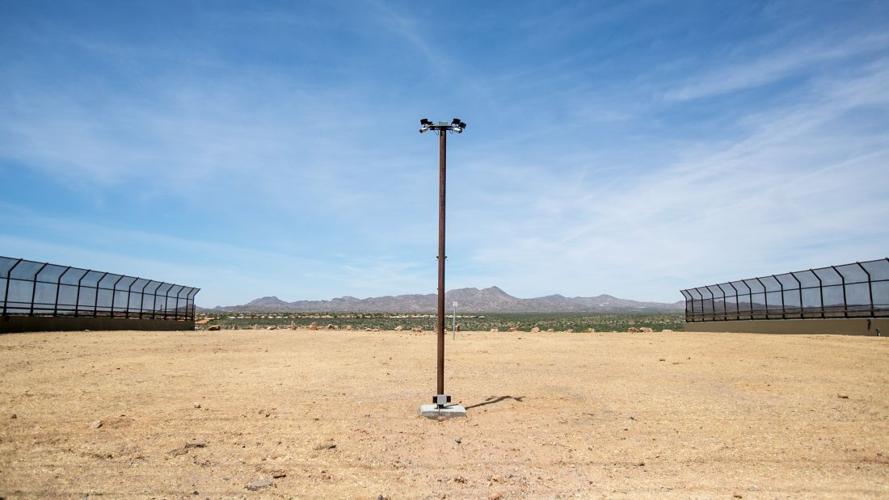Mule deer walked across North Oracle Road earlier this month, an event that under normal circumstances would have caused white-knuckle driving as motorists swerved to avoid hitting them.
But these weren’t normal circumstances.
Rather than startle drivers on the roadway, the deer ambled peacefully across a wildlife bridge that spanned the road near Catalina. Video footage and photos from Arizona Game and Fish showed the deer using the new bridge along with coyote and javelina.
One of the main goals of the bridge is to connect the Coronado National Forest with the Tortolita Mountains. Those areas are home to bighorn sheep, mountain lions, bobcats, badgers, skunks and white-nose coati as well as deer, javelina and others, the Coalition for Sonoran Desert Protection said in a news release last week.
“We’ve always had an eye on connecting over Oracle Road in this area,” said Carolyn Campbell, director of the coalition, which partnered with the Sky Island Alliance, the Tucson Audubon Society, the Regional Transportation Authority and state agencies to realize the bridge project.
In 2006, the Arizona Department of Transportation identified the Oracle Road area as a critical habitat linkage in a statewide study, backed up with research from Northern Arizona University.
Although project organizers anticipated seeing wildlife using the bridge, they didn’t expect animals would use the bridge so quickly after construction finished, Campbell said.
“It was actually surprising that they were there so soon,” she said of the animals on the bridge, which is the first of its kind in the Sonoran Desert. “Usually, it takes them a little while to figure it out.”
While the bridge is being used by animals that crossed the road before — as evidenced by studies of roadkill — other species are using the bridge to cross the road for the first time.
Desert tortoises moseyed through the construction site, surprising researchers who hadn’t seen the species cross the road before. About a month ago, cameras that had been in the area for four years caught coatimundi for the first time making their way toward the bridge area, Campbell said.
The bridge project was built alongside a road-widening project this year and was funded by the 2006 Regional Transportation Authority plan.
The roughly $11 million wildlife bridge project includes an underpass for animals about one mile south of the bridge and fencing that funnels wildlife toward the bridge.
Readers, such as commenters on a May 2015 story in the Star, may question why public officials would spend money on the bridge when local roads are in bad shape.
“It’s what we voted for. It was part of the deal,” Jim DeGrood, RTA’s deputy director, said in reference to the RTA plan voters approved in 2006 that included $45 million for wildlife connectivity projects.
The wildlife bridge received wide support from local groups and helps protect wildlife and drivers from collisions, he said.
Drivers might not see deer as they drive under the bridge, but DeGrood cautioned people against assuming the bridge isn’t being used.
“The 10 seconds in your windshield as you drive by it isn’t a good representation of what’s happening out there,” he said.
State agencies recorded more than 15,000 crossings by 16 species at six underpasses along Arizona 260 during a seven-year period. More than 4,300 desert bighorn sheep crossings were recorded at three overpasses on U.S. 93 over two years.
ADOT continually works to separate vehicles and wildlife, including building overpasses, underpasses and fencing, but the agency does not have any firm plans to build more wildlife overpasses, agency spokesman Steve Elliott said in an email.
The RTA is talking with the Tohono O’odham Nation about building two more wildlife bridges for Arizona 86 near Kitt Peak, DeGrood said. The bridges and about 10 miles of fencing should cost $6.7 million.
RTA funds already were used for wildlife underpasses on Twin Peaks Road, he said, and plans for underpasses are in the works for the Tangerine Road widening project.
The “holy grail” is finding a way to get wildlife across Interstate 10, DeGrood said. But that’s not likely in the near-term, due to the fact there are no expansions planned for I-10 in the area where it is most needed, just south of Avra Valley Road.
Organizers of the bridge project are planning to hold a celebration at the bridge on Tuesday, May 10, at 9 a.m. The public is welcome.
Down the road
Drivers beware: ADOT is planning to start the final stage of paving on Interstate 10 east of Tucson this week.
Today, April 25, ADOT will pave east- and westbound ramps on I-10 at Empirita Road, Exit 292. Ramps will be closed intermittently between 6 a.m. and 6 p.m.
On Tuesday, April 26, eastbound I-10 will narrow to one lane as crews start paving between the Cochise County line and Arizona 90 near Benson. Work on the eastbound left lane will be done during daylight hours from Tuesday to Thursday, April 28.
ADOT will set up five-mile lane closures and significant delays are expected during peak traffic hours.
On Friday, April 29, crews will pave the left lane of westbound I-10 in the same area, between mileposts 296 and 301, during daylight hours.






